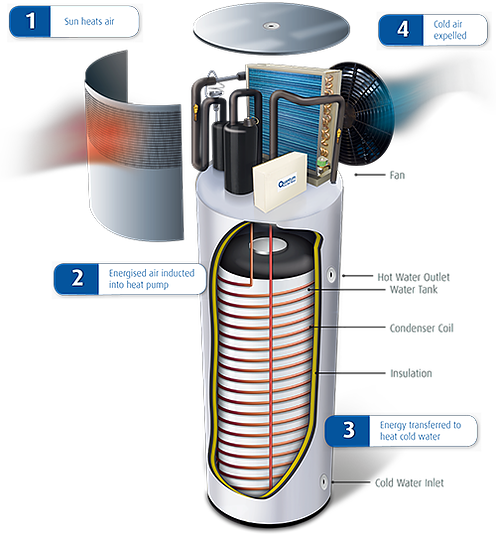We urge customers to discuss heat pump brand options with us. Our team have been industry leaders in adopting heat pump technology and have the experience to help you make the best decision.
Some heat pump units do not easily fit into the same space as your old hot water tank. In most cases the original location is the most efficient so relocating could increase the distance the hot water has to travel, leading to increased water usage.
In addition, there are some units that use flammable gas. Not only is this a dangerous option but it also restricts where the unit can be installed.
When choosing a hot water system, if you are looking for efficiency and convenience, it is hard to look past the heat pump technology.
We have been installing an increased amount of heat pump hot water systems for our Brisbane & Gold Coast customers over the last few years. They have gained a lot of popularity lately due to their ability to lower electricity costs.
A heat pump makes use of heat in the air around the tank in a reverse refrigration process to heat water in the tank, and by doing so uses less energy.
Whilst earlier generation pumps of all brands had their own maintenance issues and a less-than satisfactory life expectancy, the new generation heat pumps have addressed much of these issues and can even run with ambient temperatures as low as -10 degrees Celsius.
They have also come down in price since introduction. They are even better value now and the cost savings over a standard hot water system kick in much quicker (when you consider the smaller difference in price between a cheaper pressure system and a heat pump).
In combination; a cheaper price, better life cycle and lower running costs mean you start saving money much faster than ever before with a Heat Pump.
So how do they really work?
Technically, a heat pump works in the following ways:
- Sun heats ambient air (without need for direct sunshine, unlike solar)
- Inducted air passes over an evaporator that preheats a refrigerant that boils at low temperature. The preheated refrigerant is then compressed and this superheats the refrigerant.
- This superheated refrigerant passes through a condensor that is wrapped around the tank, transferring its heat via heat exchange through the tank walls. The volume of water inside the tank is thus heated from the outside in.
- Cold air is a byproduct of the cycle and it is expelled from the heat pump via a fan. Refrigerant liquid moves back into the condensor to begin the whole process again until desired tank temperature is reached.
Below is a video from the Hydrotherm brand explaining how heat pump systems work.
They install in nearly the same way as a normal pressurised tank, so are a viable, easy replacement for the traditional tank.
Why not just solar? : Solar hot water systems have a higher initial capital outlay, typically twice that of an equivalent heat pump.
They do harness the power of the sun, but need to be boosted at times of low sunlight and when you run out of hot water. So they do incur an electrical running cost as well.
With the new heat pump technologies, we believe at an all-in-cost comparison, they are superior to all other systems and technologies.

The best way to choose the right system is to purchase through a professional technician that is experienced in the industry. Our technicians spend all day (and night) servicing, repairing and installing hot water systems so they can advise which hot water system will suit your requirements the best.
If you are based in Brisbane, Gold Coast or Tweed Heads call Speedy Hot Water on 1800 722 458 for heat pump hot water system installations, advice and quotation information.


